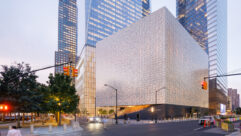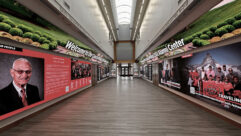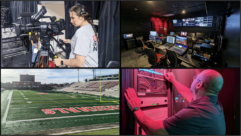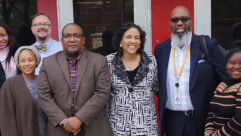
The Buzz: Installation Spotlight: Richard E. Lindner Athletics Center, University of Cincinnati
Dec 1, 2007 12:00 PM,
By Laura Dixon
Athletic Vision

Whether their sport of choice is soccer, swimming, or football, student athletes considering the University of Cincinnati (UC) will find themselves welcomed by an elaborate presentation of athletic history in UC’s new George and Helen Smith Museum.
The museum, located in an atrium in the Richard E. Lindner Athletics Center, is the product of a unique team effort by Chicago design firm Perkins+Will, Michigan-based fabrication firm Xibitz, and Grand Rapids, Mich.-based systems integrator and content producer Intaglio. Those companies brought technical ability to specifying and installing audiovisual equipment for the space, and they produced integrated content that captured the vision of Bob Goin, UC’s former athletic director, for the museum: to use AV technology to convey the rich history of the athletic programs at the university.
According to Brian Weatherford, senior associate and account director at Perkins+Will, UC was originally going to bid out the project, but it instead offered Perkins+Will the job on a design/build basis.
“Because the university made the decision to give all elements of the installation to one group, they ended up with a strong integrated approach that tied into all the physical elements of the museum to the 2D graphics, and then down into the AV aspect of it,” Weatherford says. “When you’re in that space, you have a great sense of it being one vision for the university.”

AV WITH IMPACT
Two main AV components — three 100in. stacked HoloPro screens in the atrium and the Elo TouchSystems monitors embedded in the Celebration Walk, a display feature that gives each sport a place of honor — integrate hardware and content with the museum’s central atrium environment to create impact. According to Weatherford, the transparent HoloPro screens were chosen not only for dramatic effect, but also to avoid blocking the view from one end of the atrium to the other.
“[The screens were] just a very powerful focal point in the environment,” Weatherford says. “What we were trying to get was the appearance of these screens floating in the atrium, so it had a very light, airy effect, but then the images were what you focused on.”
The screens also allow the university to tailor the content it presents to the individual student athletes it hosts. The system includes a CP2E control system processor and a C2N-TTVM TV/FM tuner from Crestron, with a Crestron CNRFHT-30A wireless RF remote that allows the tour guides to change the content being displayed. “At a certain point in the tour, they could switch [from a university piece] to a scouting report on that student athlete, for instance,” says Peter Larson, founder and chief creative officer of Intaglio.
The other main AV component in the space, the Celebration Walk, balances what Weatherford calls the “monumental contact with video” provided by the HoloPro screens with a more intimate interaction with each of UC’s 13 varsity sports. Thirteen 10in. monitors embedded in the wall offer representations of each sport, complete with customized audio. As visitors move along the display, motion sensors activate content on each monitor. An Enseo 16-channel Star video server serves the entire display.
Both components created their share of challenges. For instance, installing the HoloPro screens at the correct angle of projection, including determining the correct placement of the three Christie LX-100 10,000-lumen video projectors chosen for the project required a lot of math and several rounds of communication directly with HoloPro engineers in Germany, according to Larson and Shawn Hager, project manager at Xibitz.
Mounting each projector under a balcony overhang at the proper angle required calculating the dimensions of the balcony, the angles of the projector to the screens, and the angles of the screens themselves. They chose a Silicon Optix Image AnyPlace video scaler to super keystone the image, allowing for the extreme projection angle required for the installation.
Content production on the Celebration Walk brought its own challenges, including generating content from still images because video was not available, and adding audio components for each sport that would be complementary, rather than competing with each other in the atrium configuration of the space. Keeping the audio from the football content separate from the audio track of a more tranquil rowing video, for instance, was a challenging task.
The university’s athletics program has reaped the benefits from the effort exerted by the installation team. The installation captures visitors’ attention and creates a lasting memory of their visit to the college to take with them. “[The museum is] not an environment that you just walk in and walk through,” Hager says.
- Sound & Video Contractor EXTRA
- Houses of Worship
- Corporate AV
- Residential AV
- AV Over Fiber
- AV in Education
Breaking industry news in your email inbox every other week!
Subscribe atwww.svconline.com










